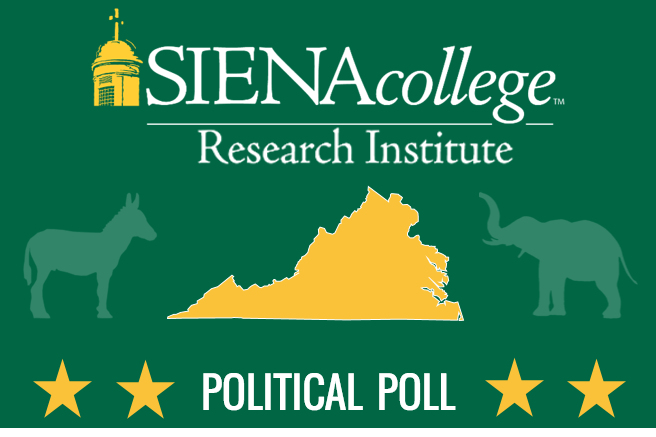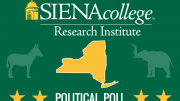New York Times Upshot/ Siena College Florida Poll:
Clinton 41 Trump 40 in Four-Way Sunshine State Race
Rubio Tops Murphy by Six Points
Florida Closely Divided on Key Issues: Obamacare, Immigration, Wall with Mexico, Govt. Stimulus & 2nd Amendment
Loudonville, NY. Former Secretary of State Hillary Clinton and businessman Donald Trump are nearly tied in a four-way race for Florida’s key electoral votes, according to a New York Times Upshot/Siena College Research Institute poll of likely Florida voters released today. Clinton currently has the support of 41 percent of likely voters to Trump’s 40 percent with former Governor Gary Johnson garnering 9 percent and Green Party Candidate Jill Stein with 2 percent. Senator Marco Rubio leads his Democratic challenger, Congressman Patrick Murphy by 48 to 42 percent.
Likely voters support passage of additional federal gun control legislation (49-43 percent), oppose building a wall the length of the Mexican border (50-43 percent), and favor, rather than oppose government stimulus programs (44-37 percent). But, they disapprove of the Affordable Care Act (51-42 percent), and are evenly divided when it comes to deporting undocumented immigrants here illegally (44-43 percent).
“Trump has as large a lead among Republicans (78 points) as Clinton does with Democrats (77 points) and independents are evenly split at 34 percent for Trump and 32 percent for Clinton with 18 percent for Johnson. Women lean towards Clinton but men tend to support Trump,” said Siena College Poll Director Don Levy. “Trump leads in the North, Bay Area and Central portions of the state, while Clinton leads in the vote rich Southeast and the Southwest is a toss-up.
“There is not only a significant gender gap in this race, but also large racial divides,” Levy said. “Trump is up 51 to 30 percent among white voters, while Clinton has a commanding 82-4 percent lead with African-Americans and 61-21 percent among Hispanics/Latinos.”
“Both candidates suffer from a majority of Florida voters having an unfavorable opinion of them. Clinton is viewed favorably by 40 percent and unfavorably by 53 percent while Trump’s numbers are 39 positive and 55 percent negative. Equal percentages, 37 percent, view one of the candidate’s favorably and the other negatively while 15 percent view them both unfavorably and only 2 percent have a favorable opinion of both. Majorities of Blacks and Latinos view Clinton favorably while half of white likely voters have a favorable opinion of Trump. Of those with an unfavorable opinion of both, a third say they will vote for Johnson, 22 percent for Clinton and 17 percent for Trump,” Levy said.
Florida is not only a battleground state on the Presidential vote but on five key national issues, no more than 9 points separate supporters and opponents on each issue. A small majority, 51 to 42 percent disapprove of the Affordable Care Act but while Republicans and independents disapprove, Democrats approve of the law. While a majority disapprove in four areas of the state, a plurality in the Southeast, approves of Obamacare.
Statewide pluralities stand in favor of government stimulus programs (44 to 37 percent) and additional gun control legislation (49 to 43 percent), but white voters oppose both. Voters in the North including the Panhandle support government stimulus, but oppose gun control while voters in the Southwest and Southeast support both issues. Statewide, voters are evenly split on deporting undocumented immigrants here illegally but Democrats, young voters, African-American and Hispanic voters and those from the Southeast oppose deportation while Republicans and voters from the Bay Area and Central Florida support it. And on building a wall on the Mexican border, Republicans, men, white voters and those from Central support it while Democrats, independents, younger voters and minorities oppose it.
“Right now, Florida is a toss-up. Beneath tied scores on vote choice and issue preferences rest varied competing groups and interests. Voters are split on which candidate they support and they disagree on many issues of the day. Different groups and regions see the issues and the candidates through very different lenses. With favorability ratings pretty well baked in and issue positions unlikely to change, the turnout battle, region by region, demographic by demographic, is likely to decide this crucial swing state,” Levy said.
# # #
This New York Times Upshot/Siena College survey was conducted September 10-14, 2016 by telephone calls to 867 likely voters. Calls were made to a stratified weighted sample of voters from the L-2 Voter list via both land and cell phones. Interviews were conducted in English and Spanish. A likely-to-vote probability was computed for each respondent based on both their stated likelihood to vote as well as by virtue of the imputation of a turnout probability score based on past voting behavior applied to their specific voting history. This probability to vote was applied as a weight along with a weight that considered party registration, age, region, gender and race. This poll has a margin of error of +/- 3.3 percentage points. The Siena College Research Institute, directed by Donald Levy, Ph.D., conducts political, economic, social and cultural research primarily in NYS. SRI, an independent, non-partisan research institute, subscribes to the American Association of Public Opinion Research Code of Professional Ethics and Practices. For more information, please call Don Levy at 518-783-2901. Survey cross-tabulations and frequencies can be found at: www.Siena.edu/SRI/SNY. This collaboration between New York Times Upshot and the Siena College Research Institute is dedicated to transparency and welcomes any requests for data as well as discussion of methodology.





